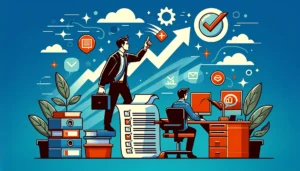Maximising focus
- 4 Min Read
Even in our post-GDPR world, we are constantly bombarded by marketing messages. Images, text and videos – emails, print ads and radio all vying for our attention on the daily commute. Mobile phones are an ever-present device too. According to the 2017 Deloitte Global Consumer Mobile Survey, more than a half (55%) of UK adults check their smartphone within 15 minutes of waking up, and adults aged 40-50 check their phone 33 times a day on average.
- Author: Julia Lindsay
- Date published: Jun 21, 2018
- Categories

Beyond these practical distractions, there’s the mental overwhelm to deal with too. We’ve lived in a volatile, uncertain, complex and ambiguous (VUCA) world for a generation already. We’ve had to adapt to the fact that change is the norm and there’s a constant need to stay ahead – to evolve or risk becoming extinct. Many jobs being filled today didn’t exist 20 years ago. And it’s expected that in a decade’s time, 60% of jobs will be completely new compared to today (1).
For employees managing all this is hard enough, but as a leader it can feel like an endurance event: racing to keep up with the ever-increasing pace of change; vying for talented people who are in high demand but short supply; delivering a mounting list of tasks with fewer resources and less time. Against this backdrop, we know that burn out is a real problem. Stress, anxiety and mental health issues are an everyday reality.
But it’s not all doom and gloom. It doesn’t have to be this way.
Leaders can create environments where people want to learn, where they get things done and done well. They can provide focus and enable people to spend more time on task in a place where they love to work. And here’s how.
Research has shown that how happy people feel at work directly impacts the time they spend on task. Data gathered from nearly 60,000 respondents showed that employees who are happiest at work report being “on task” 80% of their working week. That’s four days a week – a pretty good result as it would be impossible for anyone to be on task 100% of the time.
On the other hand, employees who are really unhappy at work spend only 40% of their time on task. That’s just two days a week and represents a huge cost to any organisation. As a result, an organisation is losing about 100 days’ work – or about 3.5 months for every really unhappy employee.
Increased time on task isn’t the only benefit of happy workers
As well as spending more time on task, the happiest employees demonstrate other high-performance behaviours as they:
- Take one tenth the sick-leave of their least happy colleagues – reducing absence
- Are six times more energised – increasing productivity
- Intend to stay twice as long in their organisations – reducing turnover
So how can you improve feelings of happiness at work? We define Happiness at Work as a mindset which enables action to maximise performance and achieve potential. It is influenced by five key factors:
- Contribution: what you do
- Conviction: your short-term motivation
- Culture: your feeling of fit
- Commitment: your long-term engagement
- Confidence: your self-belief
Here’s three things you can do today to directly influence happiness at work – and thereby increase time on task.
- Build long-term engagement by using stories and narrative to inspire others – help them understand why what they are doing matters.
- Ensure everyone has clear goals in place that directly link to your company purpose – so they understand what they should be doing and how it fits.
- Ask yourself – what control can I gave away? Empower your teams by giving them the freedom to get on with their tasks.
Happiness at work is a resource that drives engaged behaviours, creativity and resilience even in tough times. It provides a solid foundation to build a thriving agile workplace in which people can achieve to their potential.
- Forbes; The Rise of the Freelancer Economy 23 Jan 2016
- iOpener Institute for People and Performance: Research on Science of Happiness at Work, 2005-2018
About the author
Julia Lindsay, CEO of iOpener Institute for People and Performance









